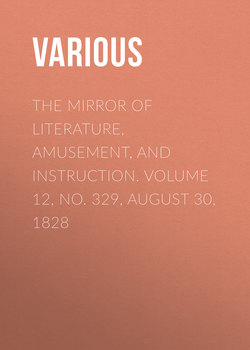Читать книгу The Mirror of Literature, Amusement, and Instruction. Volume 12, No. 329, August 30, 1828 - Various - Страница 1
NEW CHURCH, BUILDING AT STAINES
ОглавлениеWho has journeyed on the Exeter road without noticing the town of STAINES, with its host of antiquarian associations—as the Stana (Saxon) or London Stone,1 its ancient bridge, for the repair of which three oaks out of Windsor Forest were granted by the crown in the year 1262, besides pontage or temporary tolls previous to the year 1600.—Dr. Stukeley's conjectures respecting the Via Trinobantica passing here—and the old parish church, the situation of which appeared to denote the site of the more ancient town of Staines. It is here too, that the tourist begins to imagine himself in rure, after he has been whirled through the brick and mortar avenues of Kensington, and Hammersmith, and the unsightly lane-street of Brentford,2 with all its cockney reminiscences of equestrianism and election squabbles; Hounslow and its by-gone days of highway notoriety and powder-mill and posting celebrity, and Bedfont, with its yew trees tortured into peacock shapes, and the date 1704. Then, who does not recollect and venerate the convivial celebrity of this route, its luxurious inns, and their "thrones of human felicity;" along which Quin, Dr. Johnson or Shenstone could scarcely have accomplished a stage a day!
In our days, hundreds of London tourists breakfast at the Bush, although, after sixteen miles' ride, their appetites do not require this stimulant any more than do the glories of the Bush cellars after dinner.
But we must pass on to the church. The old building was in the Gothic or pointed style, with lancet windows, &c., but much disfigured by churchwardens' repairs, although the great Inigo Jones is said to have built its square, brick tower. At length, a considerable portion of this ancient structure fell in one Sunday morning, during the service, but, as the newspapers say, "fortunately no lives were lost." The inhabitants then resolved to rebuild nearly the whole, and the design of Mr. J.B. Watson was adopted. The foundation stone was laid March 31, in the present year, and the building is to be completed by Christmas next. The church is intended to contain 1,100 persons. The length of the interior, 65 feet; width, 47 feet; height to ceiling, 25 feet. The chancel is to be rebuilt at the expense of the impropriators. The lower part of Inigo Jones's tower is to remain, and the whole is to be raised 23 feet. These repairs, with the enclosure of the churchyard, will not exceed 4,000l.; and the progress of the undertaking is highly creditable to the taste and execution of all the parties concerned.
As one act of public spirit generally leads to another, the erection of a new stone bridge is projected at Staines; it is to be nearer the church than the present bridge, and will afford a better view of the new structure. An elegant stone bridge was erected here in 1796, but two of the piers sinking, the bridge was taken down, and an iron one substituted; this failed, and has since been supported by wooden piles and frame-work.
1
This is a boundary stone which marks the extent of the jurisdiction possessed by the City of London over the western part of the River Thames. It stands on the margin of the river, in the vicinity of Staines church, and bears the date of 1280. On a moulding round the upper part is inscribed "GOD preserve the City of London, A.D. 1280."
2
George II. used to say when riding through Brentford, with his heavy guards, "I do like dis place, 'tis so like Yarmany."
